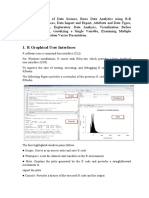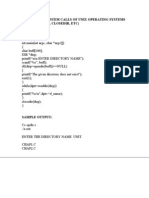0%(2)0% found this document useful (2 votes)
3K viewsMachine Learning Using Python Project (PPT)
Machine learning is a field of artificial intelligence that allows computers to learn without being explicitly programmed. It involves computers learning from large amounts of data to recognize patterns and make predictions. Specifically, machine learning is a branch of artificial intelligence that uses statistical techniques to give computer systems the ability to "learn" with data, without being explicitly programmed. Deep learning is a subset of machine learning that allows systems to learn complex patterns from large datasets. This document provides examples of machine learning techniques like regression, classification, clustering, and their uses. It also discusses Python libraries commonly used for machine learning like NumPy, SciPy, Matplotlib, and Scikit-Learn.
Uploaded by
Sakura chanCopyright
© © All Rights Reserved
Available Formats
Download as PDF, TXT or read online on Scribd
0%(2)0% found this document useful (2 votes)
3K viewsMachine Learning Using Python Project (PPT)
Machine learning is a field of artificial intelligence that allows computers to learn without being explicitly programmed. It involves computers learning from large amounts of data to recognize patterns and make predictions. Specifically, machine learning is a branch of artificial intelligence that uses statistical techniques to give computer systems the ability to "learn" with data, without being explicitly programmed. Deep learning is a subset of machine learning that allows systems to learn complex patterns from large datasets. This document provides examples of machine learning techniques like regression, classification, clustering, and their uses. It also discusses Python libraries commonly used for machine learning like NumPy, SciPy, Matplotlib, and Scikit-Learn.
Uploaded by
Sakura chanCopyright
© © All Rights Reserved
Available Formats
Download as PDF, TXT or read online on Scribd
You are on page 1/ 8
What is Machine Learning ?
• Field of study that gives computers the ability to learn without
being explicitly programmed ~ Arthur Samuel
• A computer program is said to learn from experience E w.r.t
some class of tasks T and performance measure P , if it’s
performance at tasks in T , as measured by P , improves with
experience E .
• Example :- playing checkers
• E = The experience of playing many games of checkers.
• T = The task of playing checkers.
• P = The probability that the program will win the next game.
•AI (Artificial Intelligence) tries to make computers intelligent in order to
mimic the cognitive functions of humans .It’s a general field with broad
scope including: Computer vision , Language Processing , Creativity , and
Summarization.
•ML is the branch of AI that covers the statistical part of artificial
intelligence. It teaches the computer to solve problems by looking at
hundreds or thousands of examples.
•Deep learning is a very special field of ML where computers can actually
learn and make intelligent decisions on their own , it involves a deeper level
of automation.
•Data science is the science of extracting knowledge and insights of data, the
output often is a slide deck that summarizes conclusions.
•For example :- To differentiate between whether a patient is at risk of
developing a benign or malignant tumor ,you need to obtain a dataset
containing characteristics of thousand of human cell samples extracted from
patients. We can use the values of these cell characteristics in samples from
other patients to give an early indication of whether a new sample might be
benign or malignant.
•After this comes the cleaning of data , selecting a proper algorithm for
building a prediction model , and training the model to understand patterns of
benign or malignant cells within the data.
•Once the model has been trained by going through data iteratively , it can be
used to predict your new or unknown cell with a rather high accuracy .
•Regression/Estimation : It’s used for predicting a continuous value .
•Classification Technique: It’s used for predicting the class or category of
a case.
•Clustering : Finding the structure of data ; summarization.
•Association Technique : It’s used for finding items and events that often
co- occur.
•Anomaly Detection : Is used to discover abnormal and unusual cases.
•Sequence Mining : Is used for predicting the next event .
•Dimension Reduction : Is used to reduce the size of data.
•Recommendation systems : This associates people’s preferences with
others who have similar tastes, and recommends new items to them .
Python For Machine Learning :
•NumPy is a math library to work with N – dimensional arrays in
python .It enables you to do computation efficiently and effectively
.
•SciPy is a collection of numerical algorithms and domain specific
toolboxes, including signal processing , optimization , statistics
and much more. SciPy is a good library for scientific and high
performance computation.
•Matplotlib is a very popular plotting package that provides 2D
plotting , as well as 3D plotting .
•Scikit Learn is a free Machine learning library for the python
programming language. It has most of thr classification,
regression and clustering algorithms.
Whenever you submit details about your email or contact
number on any platform, it has become easy for those platforms
to market their products by advertising them by sending email
or by advertising them by sending messages directly to your
contact number. This results in lot of spam alerts and
notification in your inbox. This is where the task of spam
detection comes in.
•Spam detection means detecting spam messages or emails by
understanding text context so that you can only receive
notifications about messages or emails that are very important
to you .
•Start this task by importing the necessary python
libraries and the dataset you need for this task.
•From the dataset , class and messages are the only
features we need to train a machine learning model for
spam detection .
• Then splitting the dataset into training and test sets and
train the model to detect spam messages.
•Test this model by taking a user input as a message to
detect whether it is spam or not:
•Enter a message : you won $50 cash price
•[‘ spam’] .
So this is how you can train a machine learning model for
the task of detecting whether an email or a message is
spam or not. A spam detector detects spam messages or
emails by understanding text context so that you can only
receive notification about messages or emails that are very
important to you .
Thankyou Submitted to : Saurab sir
Submitted by : Shruti Nagrath
You might also like
- Unit 1 - Machine Learning - WWW - Rgpvnotes.inNo ratings yetUnit 1 - Machine Learning - WWW - Rgpvnotes.in23 pages
- Lab Manual: 18CS3262S Data Modelling and Visualization Techniques33% (3)Lab Manual: 18CS3262S Data Modelling and Visualization Techniques17 pages
- GE3151 Problem Solving and Python Programming Question Bank 1No ratings yetGE3151 Problem Solving and Python Programming Question Bank 16 pages
- CS-605 Data - Analytics - Lab Complete Manual (2) - 1672730238No ratings yetCS-605 Data - Analytics - Lab Complete Manual (2) - 167273023856 pages
- Fake Job Post Detection Using Machine Learning100% (1)Fake Job Post Detection Using Machine Learning24 pages
- KNN Is A Very Simple Algorithm Used To Solve Classification Problems. KNN Stands For K-Nearest Neighbors. K Is The Number of Neighbors in KNN0% (1)KNN Is A Very Simple Algorithm Used To Solve Classification Problems. KNN Stands For K-Nearest Neighbors. K Is The Number of Neighbors in KNN9 pages
- Telco Customer Churn Prediction Project ReportNo ratings yetTelco Customer Churn Prediction Project Report40 pages
- Chapter 6 - GUI and Interactive Input MethodsNo ratings yetChapter 6 - GUI and Interactive Input Methods18 pages
- Unit 1 Introduction of Machine Learning NotesNo ratings yetUnit 1 Introduction of Machine Learning Notes57 pages
- Software Project Management: Nehru Institute of Engineering and TechnologyNo ratings yetSoftware Project Management: Nehru Institute of Engineering and Technology39 pages
- Phishing Website Detection by Machine Learning Techniques PresentationNo ratings yetPhishing Website Detection by Machine Learning Techniques Presentation12 pages
- A Comparative Study On Fake Job Post Prediction Using Different Data Mining Techniques100% (1)A Comparative Study On Fake Job Post Prediction Using Different Data Mining Techniques5 pages
- Program For System Calls of Unix Operating Systems (Opendir, Readdir, Closedir, Etc)No ratings yetProgram For System Calls of Unix Operating Systems (Opendir, Readdir, Closedir, Etc)7 pages
- Ai & ML Lab Manual (As Per 2018 Scheme)No ratings yetAi & ML Lab Manual (As Per 2018 Scheme)42 pages
- Campus Placement Analyzer: Using Supervised Machine Learning AlgorithmsNo ratings yetCampus Placement Analyzer: Using Supervised Machine Learning Algorithms5 pages
- 1.3. Underlying Principles of Parallel and Distributed ComputingNo ratings yet1.3. Underlying Principles of Parallel and Distributed Computing118 pages
- Gold Price Prediction Using Ensemble Based Supervised Machine Learning100% (2)Gold Price Prediction Using Ensemble Based Supervised Machine Learning30 pages
- E-Travel Booking Site: Submitted As A Part of0% (1)E-Travel Booking Site: Submitted As A Part of23 pages
- Computer Hardware Repair & Maintenance - 0No ratings yetComputer Hardware Repair & Maintenance - 046 pages
- RemoteConnect and SCADAPack x70 Utilities R2.6.1-Release NotesNo ratings yetRemoteConnect and SCADAPack x70 Utilities R2.6.1-Release Notes12 pages
- Dell Inspirion 15 5551 Compal LA-B912P r1.0No ratings yetDell Inspirion 15 5551 Compal LA-B912P r1.042 pages
- Root Locus Analysis in Z Plane: Dr. Sadeq Al-Majidi0% (1)Root Locus Analysis in Z Plane: Dr. Sadeq Al-Majidi10 pages
- Programming For The Java TM Virtual Machine PDF100% (1)Programming For The Java TM Virtual Machine PDF517 pages
- Object Oriented Programming Lab Manual (Lab 03)No ratings yetObject Oriented Programming Lab Manual (Lab 03)10 pages
- Lab Manual: 18CS3262S Data Modelling and Visualization TechniquesLab Manual: 18CS3262S Data Modelling and Visualization Techniques
- GE3151 Problem Solving and Python Programming Question Bank 1GE3151 Problem Solving and Python Programming Question Bank 1
- CS-605 Data - Analytics - Lab Complete Manual (2) - 1672730238CS-605 Data - Analytics - Lab Complete Manual (2) - 1672730238
- KNN Is A Very Simple Algorithm Used To Solve Classification Problems. KNN Stands For K-Nearest Neighbors. K Is The Number of Neighbors in KNNKNN Is A Very Simple Algorithm Used To Solve Classification Problems. KNN Stands For K-Nearest Neighbors. K Is The Number of Neighbors in KNN
- Software Project Management: Nehru Institute of Engineering and TechnologySoftware Project Management: Nehru Institute of Engineering and Technology
- Phishing Website Detection by Machine Learning Techniques PresentationPhishing Website Detection by Machine Learning Techniques Presentation
- A Comparative Study On Fake Job Post Prediction Using Different Data Mining TechniquesA Comparative Study On Fake Job Post Prediction Using Different Data Mining Techniques
- Program For System Calls of Unix Operating Systems (Opendir, Readdir, Closedir, Etc)Program For System Calls of Unix Operating Systems (Opendir, Readdir, Closedir, Etc)
- Campus Placement Analyzer: Using Supervised Machine Learning AlgorithmsCampus Placement Analyzer: Using Supervised Machine Learning Algorithms
- 1.3. Underlying Principles of Parallel and Distributed Computing1.3. Underlying Principles of Parallel and Distributed Computing
- Gold Price Prediction Using Ensemble Based Supervised Machine LearningGold Price Prediction Using Ensemble Based Supervised Machine Learning
- Introduction to Linux: Installation and ProgrammingFrom EverandIntroduction to Linux: Installation and Programming
- RemoteConnect and SCADAPack x70 Utilities R2.6.1-Release NotesRemoteConnect and SCADAPack x70 Utilities R2.6.1-Release Notes
- Root Locus Analysis in Z Plane: Dr. Sadeq Al-MajidiRoot Locus Analysis in Z Plane: Dr. Sadeq Al-Majidi

























































































